![]()
![]()
![]()
Use LEFT and RIGHT arrow keys to navigate between flashcards;
Use UP and DOWN arrow keys to flip the card;
H to show hint;
A reads text to speech;
16 Cards in this Set
- Front
- Back
|
Within the realm of organizational structure, what are the different types of departmentalization? (just the names)
|
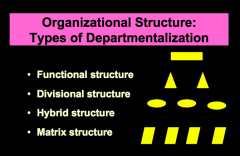
|
|
|
Describe the functional structure
|
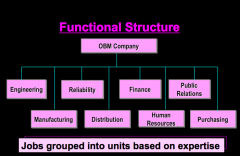
Jobs are combined according to the functions of the organization
The principal advantage is efficiency By having departments of specialists, management creates efficient units A major disadvantage is that organizational goals may be sacrificed in favor of departmental goals |
|
|
Describe the divisional structure
|

|
|
|
What are the departmentalization bases? Explain each
|
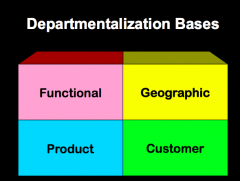
|
|
|
Describe the matrix org setup and explain the advantages
|
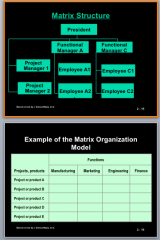
Advantages include the following:
Efficient use of resources Flexibility in conditions of change and uncertainty Technical excellence Freeing top management for long-range planning Improving motivation and commitment Providing opportunities for personal development |
|
|
Describe the boundary-less organizational structure
|

A boundaryless organizational structure enables an orga- nization to form relationships with customers, suppliers, and/or competitors, either to pool organizational resources for mutual benefit or to encourage cooperation in an uncertain envi- ronment.
Companies often use a boundaryless organizational structure when they (1) collaborate with customers or suppliers to provide better-quality products or services, (2) are entering foreign markets that have entry barriers to foreign competitors, or (3) need to manage the risk of developing an expensive new technology. The boundaryless organization is appropriate in these situations because it is open to change, it facilitates the formation of joint ventures with foreign companies, and it reduces the financial risk to any one organization. |
|
|
Describe the workflow process and why it is important
|
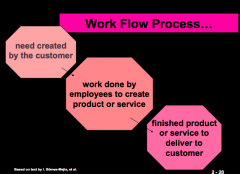
Managers need to do work-flow analysis to examine how work creates or adds value to the ongoing business processes.
Work-flow analysis usually reveals that some steps or jobs can be combined, simplified, or even eliminated. In some cases, it has resulted in the reorganization of work so that teams rather than individual workers are the source of value creation. |
|
|
What is the difference between workflow process analysis and business process reengineering? Explain BPR.
|
BPR allows to rethink and redesign business processes to achieve improvements in cost, quality, service and efficiency. Basically BPR is a bigger thing that workflow analysis, allowing a company to make major performance improvements. It's a fundamental rethinking.
|
|
|
Why is are needs important to motivation?
|
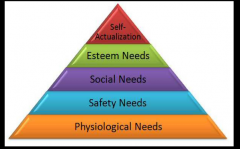
Because wanting needs to be met increases motivation, and also getting needs met increases motivation.
|
|
|
What are the things you should do when working in team (e.g. setting them up and stuff)
|
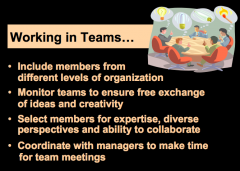
see above
|
|
|
What are the approaches to job design? Give an example of each.
|
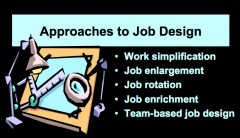
Work simplification: Work simplification assumes that work can be broken down into sim- ple, repetitive tasks that maximize efficiency. This approach to job design assigns most of the thinking aspects of work (such as planning and organizing) to managers and supervisors, while giving the employee a narrowly defined task to perform.
Job enlargement: used to redesign jobs to reduce fatigue and boredom among workers performing simplified and highly specialized work. Job enlargement expands a job’s duties. Job rotation: Redesigns jobs to reduce fatigue and boredom among workers performing simplified or highly specialized work. Rotates workers among different narrowly defined tasks without disrupting the flow of work. Job enrichment: Makes jobs more interesting and to improve employee motivation. Job enrichment puts specialized tasks to one person Team-based job design: focus on giving a team, rather than an individual, a whole and meaningful piece of work to do. |
|
|
What are the general steps in conducting a job analysis?
|
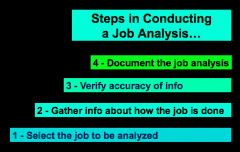
The systematic gathering and organization of information concerning jobs. Useful for communicating job expectations
|
|
|
In job analysis, what is analyzed and what information is gathered over time?
|
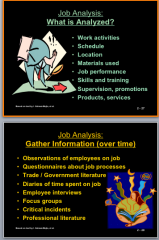
|
|
|
How is job analysis used in the org?
|
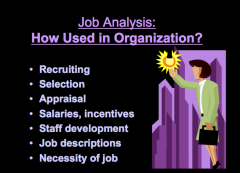
|
|
|
What are the components to job description?
|
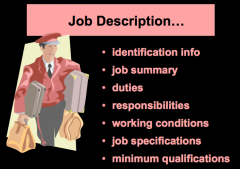
A job description is a summary statement of the information collected in the job-analysis pro- cess. It is a written document that identifies, defines, and describes a job in terms of its duties, responsibilities, working conditions, and specifications. There are two types of job descriptions: specific job descriptions and general job descriptions.
|
|
|
What are ways we can make sure our workforce will be flexible?
|
1. Contingent workers (as opposed to full-time workers) 2. Flexible work schedules (core time vs flex time, compressed work weeks and telecommuting)
3. Outsourcing (often happens with HR activities) 4. Uses of HR information systems (skills inventory, job descrip, EE info, etc) |

